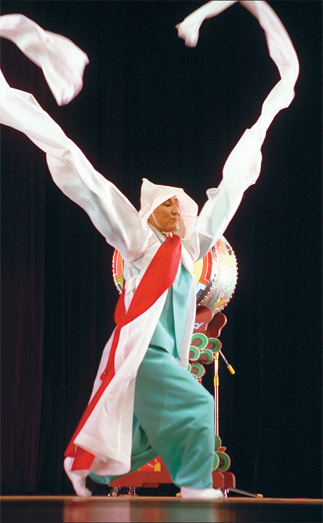Korean traditional dance

A dancer performs seungmu. Although the dance is believed to have originated among Buddhist monks, the dance itself has no religious aspects.[JoongAng Ilbo] 승무를 추고 있는 무용수. 이 춤은 불교 승려들에게서 유래된 것으로 여겨지지만, 춤 자체는 특별히 종교적 색채가 없다.[중앙일보]

Muyongchong, a painting of dancers in long sleeves on the walls of a tomb dating back to the Goguryeo period.[JoongAng Ilbo] 고구려 시대 고분인 무용총에는 긴 소매를 가진 무용수들의 그림이 그려져 있다. [중앙일보]
-intricate : 얽히고 설킨; 복잡한, 난해한
-enchant : 매혹하다, 황홀케 하다.
모든 나라에서 춤은 그 역사 속에서 복합적인 역할을 하는데 한국도 예외는 아니다. 전통 춤은 경건한 의식에서부터 크고 작은 축제에 이르기까지 어디서나 볼 수 있다. 한국을 찾은 관광객들이 한 번쯤 봤을 농악은 꽹과리 같은 전통 악기의 연주와 함께 공연되는데, 이는 독특하고 미묘한 움직임으로 사람들을 매혹시키는 수많은 한국 전통 춤 중 하나다 .
Kim Malborg, author of “Korean Dance” and a professor at Ewha Womans University, said, “The root of Korean dance is closely related to our everyday lives. It was a collective act that took place at work, during rituals and ceremonies, and during festivities as a way to express the deepest desires of the human heart.”
-ritual : (종교적) 의식, 예식
‘한국 춤’의 저자인 김말복 이화여대 교수는 “한국 전통 춤의 뿌리는 일상 생활과 밀접한 관련이 있다. 그것은 인간의 마음 속 깊은 곳의 희망을 표현하기 위해 의식이나 축제의 자리에서 행해진 집단적인 행위”라고 말했다.
Dance acted as way to alleviate the strains of daily labor, she said.
Kim Mae-ja, author of “Dance of Korea,” said Korean dance, like most dances around the world, originated from spiritual rituals.
She said Korean dance expresses solitude and han, a uniquely Korean word which can be translated as “abysmal grief.”
-alleviate : (고통을) 완화시키다. 경감하다.
-strain : 긴장, 팽팽함; 과로, 격무
춤은 또 매일 이어지는 노동의 힘겨움을 덜어주는 역할도 했다고 김 교수는 말했다.
“한국의 춤”의 저자인 김매자씨는 한국의 전통 춤은 다른 나라와 마찬가지로 정신적인 의식에서 출발했다고 말했다. 김씨는 한국의 춤이 외로움과 ‘한’을 표현한다고 말했다. ‘한’은 한국 고유의 단어로 “깊은 슬픔” 정도로 번역할 수 있다.
Korean dance follows a line that draws a circle, representing the embrace of the universe. To represent the heavens and Earth, the dancers’ feet are, at first, heavily planted on the ground. The dancer then moves slowly upward toward the heavens, lightly treading like a crane or a swan flying in the air.
-crane : 두루미; 왜가리
한국 춤의 동선은 원을 그리는 데 이는 전 우주를 받아들이는 것을 의미한다. 하늘과 땅을 표현하기 위해 무용수는 발은 처음에는 땅 바닥에 단단하게 붙어 있다. 그 뒤 무용수는 하늘을 향해 위쪽으로 천천히 움직이면서, 하늘을 나는 두루미나 백조의 모습처럼 가볍게 발걸음을 옮긴다.
<중략>
Traditional Korean dances can be generalized into three categories, according to their purpose: royal court dances, religious ritual dances and folk dances.
한국의 전통 춤은 그 목적에 따라 궁중 춤, 종교 의식 춤, 민속 춤 등 세가지로 나뉜다.










with the Korea JoongAng Daily
To write comments, please log in to one of the accounts.
Standards Board Policy (0/250자)